YFPOL: A Linear Polarimeter of Lijiang 2.4m Telescope
Yu-Xin Xin ,Jin-Ming Bai,Zhong-Quan Qu,Zhi Xu,Ji-Rong Mao,Kai Ye,Bao-Li Lun,Xu Ding,Hong-Tao Liu, Yue Zhong, Yu-Feng Fan, Xiao-Guang Yu, Liang Xu, Xiao-Bo Dong,Jian-Guo Wang, and Ding-Rong Xiong
1 Yunnan Observatories, Chinese Academy of Sciences, Kunming 650216, China; xyx@ynao.ac.cn, baijinming@ynao.ac.cn 2 University of Chinese Academy of Sciences, Beijing 100049, China
3 Key Laboratory for the Structure and Evolution of Celestial Objects, Chinese Academy of Sciences, Kunming 650216, China
4 Center for Astronomical Mega-Science, Chinese Academy of Sciences, Beijing 100012, China
Abstract Polarimetry plays an important role in investigating physical properties for celestial objects. We present a polarimeter named YFPOL for the Cassegrain focus of the Lijiang 2.4 m Telescope (LJT) of Yunnan Observatories, Chinese Academy of Sciences. YFPOL is a traditional single-beam polarimeter with a rotating polarizer. As the focal-reducer instrument Yunnan Faint Object Spectrograph and Camera (YFOSC) is always positioned on the Cassegrain focal plane of LJT, we develop two sets of ultra-thin (thickness <12 mm) polarizer rotation control systems with wireless charging and control functions,which are suitable for mounting on the two front-wheels of YFOSC. One set is used as the polarimetric calibration unit, and the other is for the polarimetric modulation unit. Both of the polarizers have an ultra-high contrast ratio of 1,000,000:1 in the optical band. We investigate the instrumental polarization characteristics (IPCs) in the full field of view that is transferred from YFOSC. Furthermore, we identify that the IPCs change when the Cassegrain axis rotates. The spurious polarization from the IPCs can be effectively minimized by flat-fielding using the unpolarized domeflat,when the Cassegrain rotation angle is the same or nearest to that of the polarization observation. We develop a quasiautomatic pipeline for YFPOL and its effectiveness has been verified by tests of the polarimetric observation with blazar S5 0716+714. The calibration is performed by observing the zero-polarized and highly-polarized standard stars. We successfully reach high precision polarization in the 7′ field of view, and the systematic uncertainty is below 0.8%for a V=11.68 target with a 10 s exposure.The instrument polarization angle offset is 2°.6.YFPOL is not only a simple polarimeter, but also a spectropolarimeter with grisms that can be considered in the future.
Key words:polarization–instrumentation:polarimeters–techniques:image processing–techniques:polarimetric
1. Introduction
Polarimetry plays a unique and important role in multiwavelength and multi-messenger astronomical observation. It opens an insightful window to study the physical processes occurring in systems from the solar system to high-redshift galaxies(Hough 2006).A completely unpolarized source is almost nonexistent. The polarization states can be generated by direct physical processes, such as cyclotron radiation, synchrotron radiation and so on. It can also be generated by indirect physical processes,such as the reflection,absorption and scattering of light.
Optical polarimetry is a very promising research field for our understanding of magnetic field evolution in jets of active galactic nuclei (AGNs) (Abdo et al. 2010; Zhang 2019;Shablovinskaya & Afanasiev 2019) and gamma-ray bursts(GRBs) (Troja et al. 2017; Mao et al. 2018). It can be also applied in the research of other fields, such as changing-look Seyfert galaxies (Marin et al. 2019), molecular filamentary clouds (Harjunpää et al. 1999), asteroids (Pan & Ip 2022),comets (Sen et al. 1990) and white dwarf pulsars (Buckley et al. 2017). Spectropolarimetry provides a new way to study supernovae(Wang&Wheeler 2008)and GRBs(Buckley et al.2021;Mao et al.2021),and a new method for measuring black hole masses in active galaxies (Afanasiev & Popović 2015;Savić et al. 2021).
Many general-purpose optical telescopes in the world have been equipped with customized polarization instruments. For example, a dual-beam polarimeter FORS2 is mounted on the Very Large Telescope (VLT), operating in both imaging polarimetric and spectropolarimetric modes (Fossati et al.2007). The fast-readout polarimeter RINGO3, mounted on the Liverpool Telescope, is a synchronous multiband imaging polarimeter with a time resolution of 1 second (Arnold et al.2012), which mainly performs polarization observation for GRBs and other transient sources. A four-channel polarimeter RoboPol is mounted on the 1.3 m Ritchey-Chrétien (R-C)telescope of the Skinakas Observatory to explore the nature of the coherent rotation of the polarization angle (PA) of blazar emission (Ramaprakash et al. 2019).
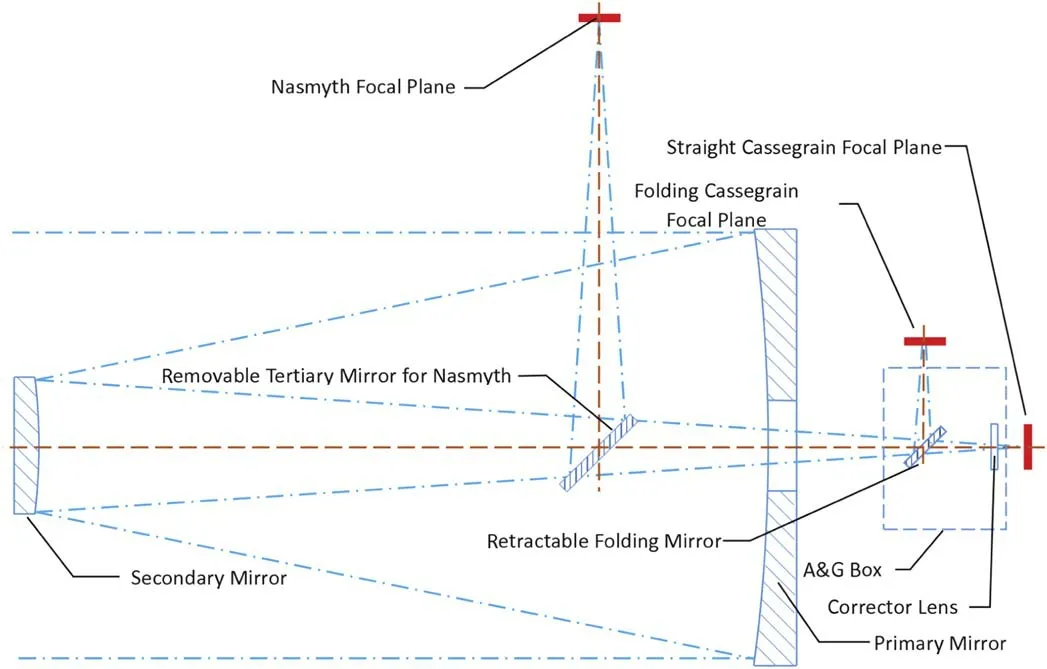
Figure 1. The optical layout of LJT.
Polarimeter designs are different,but there are only three types divided by modulation type:(1)a single-beam polarimeter:use a polaroid filter as the modulation unit (Clarke 1965; Lites 1987;Packham 2008; Słowikowska et al. 2016). (2) A dual-beam polarimeter: use a Half-Wave Plate (HWP) or Quarter-Wave Plate (QWP) as the modulation unit and Wollaston prism (WP)as the beam-splitter(Appenzeller 1967;Scarrott et al.1983;Patat& Romaniello 2006). (3) A four-beam polarimeter: use Wedged Double Wollaston (WeDoWo) as the modulation unit, which allows simultaneous acquisition of Stokes I, Q, U parameters in one sky exposure(Oliva 1997;Covino et al.2014;Ramaprakash et al. 2019; Afanasiev et al. 2021).
We have developed a single-beam polarimeter,YFPOL,and a four-beam polarimeter using WeDoWo on the Lijiang 2.4 m Telescope(LJT)since 2016.In this work,we focus on YFPOL and discuss the most relevant problems connected to the singlebeam polarimeter’s hardware and software implementation(Section 2), the effect from the observational field of view(FOV) (Section 3), error analysis (Section 4), data reduction(Section 5), calibration (Section 6), observations and results(Section 7). A summary and conclusion is given at the end(Section 8). In the Appendix we present the lists of zeropolarized and highly-polarized standard stars.
2. The Telescope and Instrument
2.1. LJT and YFOSC
The LJT is the largest general purpose optical telescope in China. It is an altitude-azimuth mounted R-C telescope,manufactured by Telescope Technologies Limited (TTL, a British company), with excellent tracking performance, as the design of robust motion control systems for the main axes implements modern H ∞control theory. LJT provides one straight Cassegrain focal plane, eight folding Cassegrain focal planes and two Nasmyth focal planes. The FOV of the Cassegrain focal plane is 10 arcminutes in normal mode,or 40 arcminutes in the case of the corrector lens(Figure 1).Actually,we do not have a wide FOV instrument, so the correction mirror has not been installed in the light path of LJT. The tertiary mirror can be moved in or out of the light path, to switch between the Nasmyth focus and the Cassegrain focus.The folding mirror also can be moved in or out of the light path, to switch between the folding Cassegrain focus and the straight Cassegrain focus (Fan et al. 2015). Therefore, the optical system of the telescope is a typical R-C system (the hyperboloid primary and secondary mirrors) for the instruments on the straight Cassegrain focus, with no extra mirrors.
The Yunnan Faint Object Spectrograph and Camera(YFOSC,Figure 2)was built by the astronomical instrumentation team at the Niels Bohr Institute, University of Copenhagen. It has been mounted on the straight Cassegrain focus of LJT since 2010, with wavelength ranging from 350 nm to 1100 nm. The detector is a back illuminated deep depletion E2V scientific CCD sensor—CCD42-90, with the 13.5 μm pixel size and 2048×4608 pixel resolution for spectrograph mode (Wang et al. 2019). The image scale is 0 283 pixel-1in the standard readout mode (not binning) and the effective FOV is 9′.8 in photometry mode (2148×2200 pixel resolution).
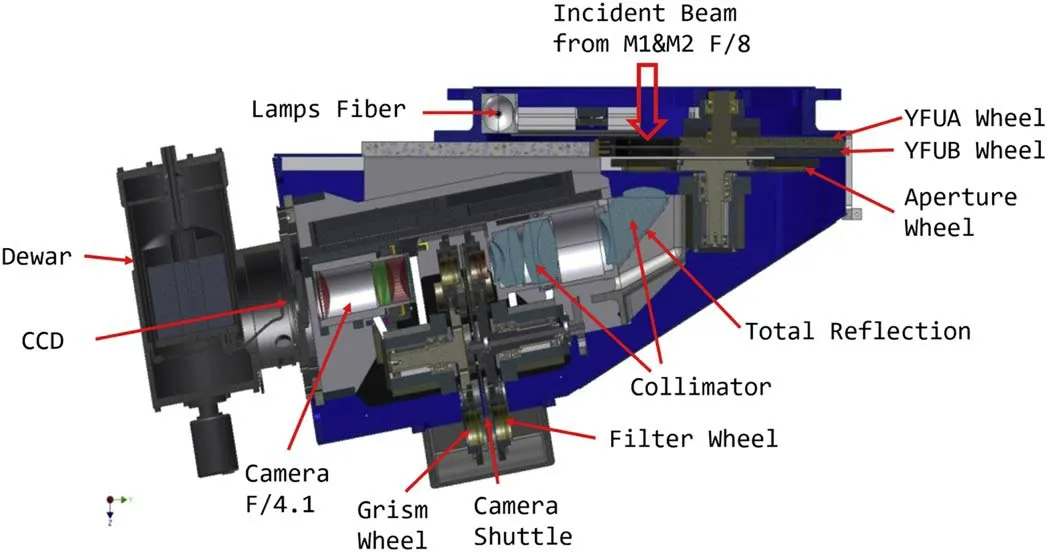
Figure 2. The internal structure diagram of YFOSC.
YFOSC is a focal-reducer instrument equipped with many observation modes, including photometry, median/low dispersion spectrograph, cross dispersion spectrograph and no-slit spectrograph.However,there is no polarimetric mode.It is a very compact instrument with no extra room to install an independent polarization modulation unit (PMU);we can only use its wheels to install the polarization components,and their thickness should not exceed 12 millimeters.Furthermore,YFOSC’s light path has a special bending design, see Figure 2. As a result, we have to give up the dual-beam polarimeter scheme.
2.2. YFPOL
YFPOL is a single-beam linear polarimeter integrated with YFOSC. It is not only a polarimeter, but also a spectropolarimeter with slits and grisms (see Figure 3). YFPOL has a polarization calibration unit (PCU, mounted on YFUA) and a PMU (mounted on YFUB), using the same high-quality wire grid polarizer, a production of Meadowlark Optics. The polarizer is broadband (the wavelength ranges from 300 nm to 2700 nm), with a 1,000,000:1 contrast ratio in the optical band(Figure 6).The diameter of the polarizer is 50.8 mm,with 44.7 mm clear aperture, corresponding to an FOV of 7′. The thickness of the polarizer is only 5 mm, plus counting the mechanical mount and the high precision rotation control system,the total thickness is only 11 mm,which is suitable for YFOSC’s wheels.
We have developed two sets of compact polarizer rotation control systems with wireless charging and control functions(Figure 4(a)),according to the size requirements of YFUA and YFUB wheels.They are used separately as PCU and PMU.The mechanical parts are designed by AutoCAD5https://www.autodesk.com/products/autocad/, and the printed circuit boards (PCBs) are designed by LCEDA6https://lceda.cn/editor; the software of Single Chip Microcomputer (MCU) is developed by MDK57https://www2.keil.com/mdk5, the rotation control software (Figure 4(b)) of the polarizer is developed in the C++ language, and the CCD control software is developed in the Java and C/C++languages.
The CCD image acquisition program and polarizer rotation control program are ran on two mutually independent computers, respectively. In order to ensure the correct acquisition of polarization modulated images, the CCD image acquisition program is always executed after the polarizer rotation program is completed. First, the high precision time synchronization between two control computers has been realized. Second, the timestamp data will be recorded automatically after each time the polarizer rotates in place.
We use Bluetooth Low Energy(BLE)technology to achieve low power consumption and stable wireless communication between the computer and the polarizer. We rely on electromagnetic induction technology to power the polarizer control circuit board. We choose a mini ultra-thin type of two phase four wire stepper motor with high deceleration ratio to drive the polarizer to rotate with high precision.We developed the PCB with bluetooth communication, motor drive and battery wireless charging functions. The home position(0 degree position) of the polarizer is determined by a Hall sensor, which is fixed on the PCB and under the rotatable polarizer mount (see Figure 4(a)). The induction magnet is embedded in the polarizer mount and rotates together with the polarizer.It takes 34 s and 39,492 motor steps for the polarizer to rotate in a circle, so the positioning accuracy is better than 0°.01. The repeated positioning accuracy is also guaranteed by keeping the polarizer always rotating in one direction, so backlash error is avoided.
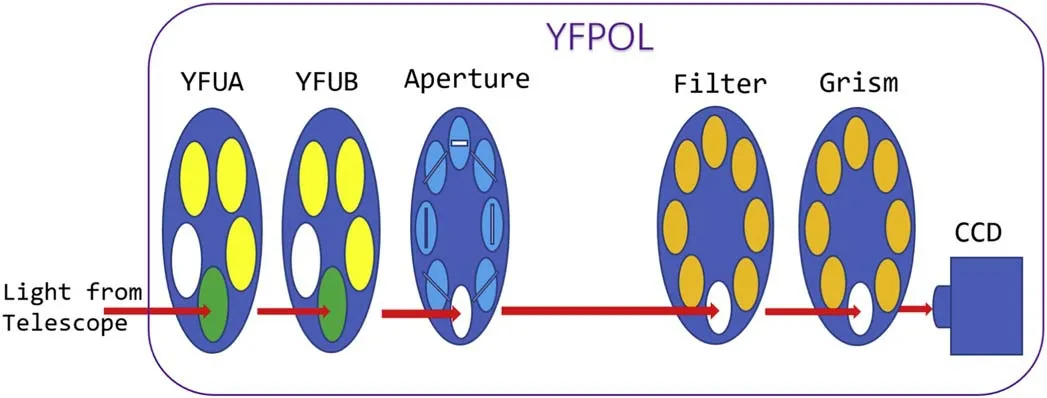
Figure 3.The schematic diagram of YFPOL.(The green color filters on the YFUA wheel and YFUB wheel are polarizers for calibration and modulation respectively.)
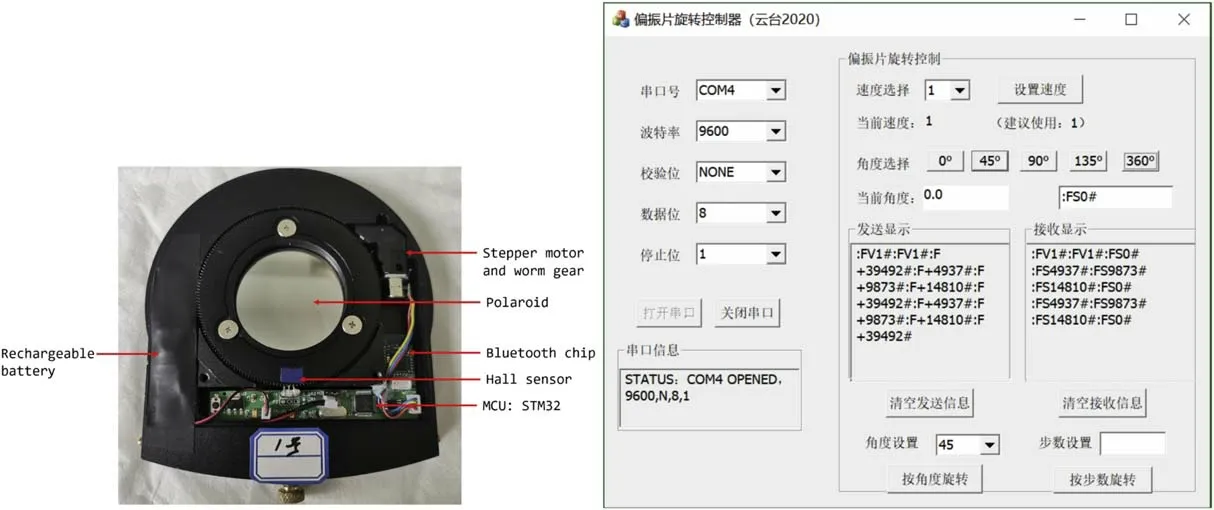
Figure 4. The rotation control system of the polarizer.
2.3. Polarizers and Filters
The polarizer is the core component of YFPOL. We have three polarizers P1, P2 and P3 of the same type. They are all produced by Meadowlark Optics. P1 is the old version polarizer (Figure 5), which we purchased in December 2016;P2 and P3 are new version polarizers (Figure 6), which we purchased in September 2021. They have the same working wavelength ranges from 300 nm to 2700 nm, but the new version polarizers have higher transmittance (>60%) and higher extinction ratio (1,000,000:1) than the old version polarizer in the optical band (400 ~700 nm). We used the old version polarizer to carry out the early polarization calibration work (see Section 6.1), and the new version polarizer to carry out the later polarization calibration work (see Section 6.2).
There are two sets of standard astronomical filters for YFPOL: Johnson/Bessel filters (Figure 7) and Sloan Digital Sky Survey Filters (SDSS, Figure 8). The multi-band linear polarization observations for YFPOL can use these two sets of filters.
2.4. Description of Stokes Parameters

Figure 5. The old version ultra broadband polarizer contrast and transmission vs. wavelength (nm) (image from Meadowlark Optics).

Figure 6. The new version ultra broadband polarizer contrast and transmission vs. wavelength (nm) (image from Meadowlark Optics).
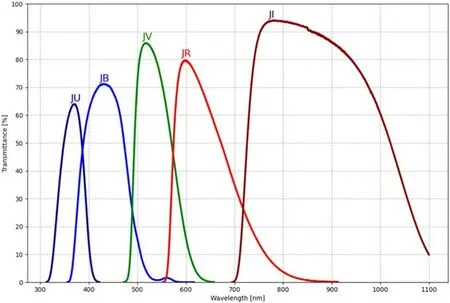
Figure 7. YFOSC’s Johnson/Bessel filter transmittance curve.
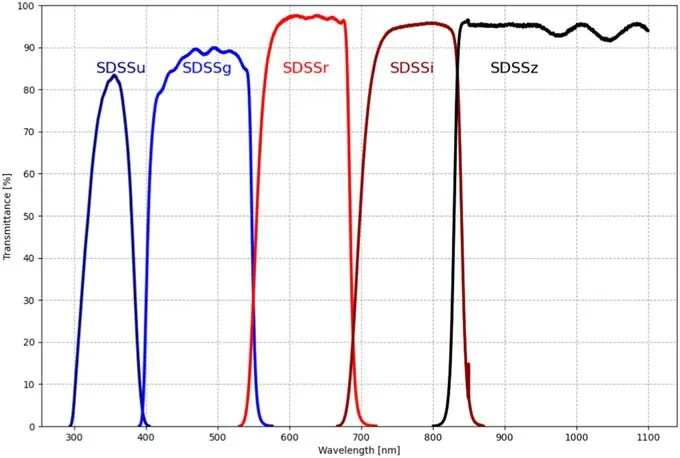
Figure 8. YFOSC’s SDSS filter transmittance curve.
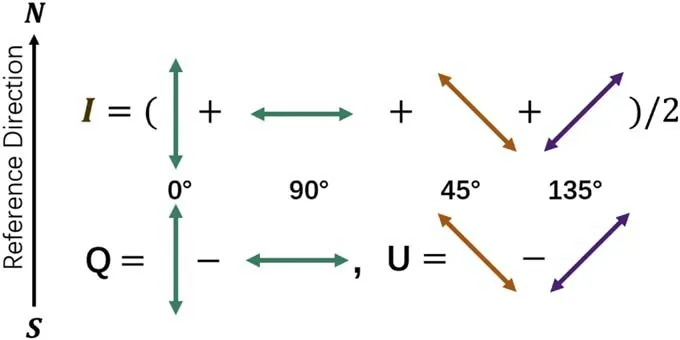
Figure 9. The geometric definition of Stokes parameters (The observer is looking toward the target).
All the light (unpolarized light or highly-polarized light) in the universe can be described through the Stokes vectors S=[I, Q, U, V]T, where I is the total intensity, Q is the linear polarization component along the N–S direction,U is the linear polarization component of 45°with respect to the N–S direction and V is the circular polarization component. The polarization properties of a Stokes polarimeter in any state can be described by a 4×4 Mueller matrix. Every polarization instrument or element has a corresponding Mueller matrix. When a beam of light with Stokes vector S passes through the polarization instrument or element with the Mueller matrix–M, we can get the Stokes vector S’ of the output light by Equation (1) as follows

The geometric definition of Stokes parameters is given by Landi Degl’Innocenti et al.(2007).For a linear polarimeter,we only probe three Stokes parameters, I, Q and U, with the geometric descriptions as shown in Figure 9. The reference direction of the PA has a standard definition for nighttime astronomy: the celestial meridian passes through the observed object (Landi Degl’Innocenti et al. 2007), which is the north–south direction illustrated in Figure 9. As an altitude-azimuth telescope, we always set the sky angle to 0 degrees for photometry or polarimetry.

The specific process of polarization observation using YFPOL is as follows:Rotating the polarizer clockwise(looking toward the polarizer) to collect images at four angles (0°, 45°,90° and 135°), and then rotating the polarizer to the home position (0 degrees) for the next observation. The temporal resolution τ of YFPOL is defined by where Tcis the time for the polarizer to rotate one cycle,which is 34 seconds;Tris the readout time of a CCD in 2k×2k mode with a speed of 400 kpixel s-1, which is 12 seconds; Teis the exposure time for each modulation angle of the target. The actual observation took a little bit longer than this. For the highly-polarized standard star HD25443 (V=6.78) with 1 s exposure time, τ is 90 s. For the blazar S5 0716+714(V=14.17) with 60 s exposure time, τ is 360 s. For a single beam polarimeter, the shorter the exposure time is, the smaller the polarization error introduced by sky background and atmospheric visibility.
By rotating the polarizer, we can get four flux intensities I0,I45, I90and I135for each set of polarization observations, and then we can calculate the Stokes I,Q and U parameters through Equations (3), (4) and (5) as follows:

After that,we can get the polarization degree (PD)and the PA through Equations (6) and (7), respectively, as follows:
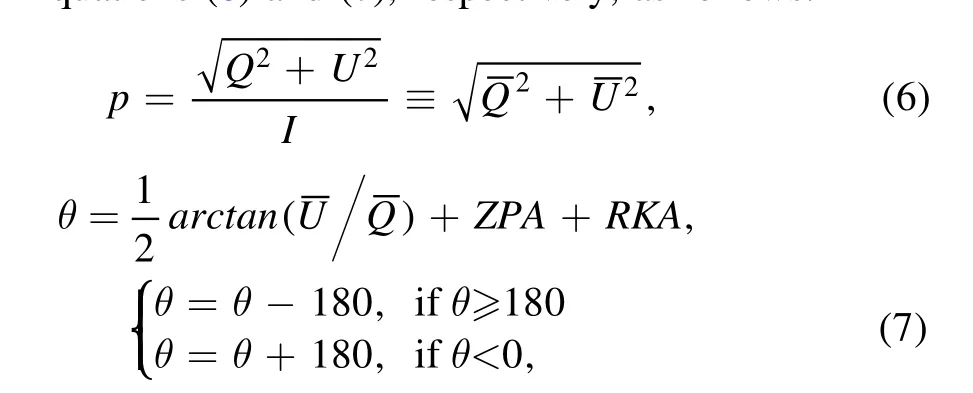
where ZPA is the Zero-Point Angle of the polarizer from the reference direction of the PA (see Figure 9), and RKA is the Rot-Sky Angle during the observation.We can get the value of ZPA from the calibration results by observing the highlypolarized standard stars (see Section 6). As the arctan is a function defined between-90° and 90°, we correct PA by±180° in Equation (7). Otherwise, the calculated PA is likely to be wrong as discussed by Landi Degl’Innocenti et al.(2007).
The direction of rotation of the polarizer needs special attention. For YFPOL, the direction of rotation is clockwise when looking toward the polarizer, or counterclockwise when looking toward the target, as illustrated in the left panel in Figure 10.If we rotate the polarizer in the opposite direction,as shown in the right panel in Figure 10,the numerator should be changed to I135-I45for Equation (5).

2.5. Preliminary Test in Lab
We tested the two versions of the polarizers in our optical laboratory in October 2021. The light source was a halogen lamp, and the light passed through the integrating sphere and then into the parallel light tube to produce parallel light. The parallel light passed through polarizer A(PCU)to generate the fully polarized light, and then passed through polarizer B(PMU) for polarization modulation, and finally entered a fiber optic spectrometer for recording the intensity of light (see Figure 11).
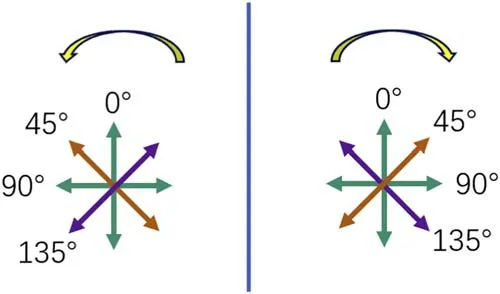
Figure 10. The direction of rotation of the polarizer (The observer is looking toward the target).
As there are one old version polarizer (P1) and two new version polarizers(P2,P3),we used P1(or P2)as PCU and P3 as PMU in the laboratory test.Before the testing,the instrument background spectrum (bias) was measured at first, as the minimum exposure time of the fiber optic spectrometer is 1 ms,and the bias spectra are not taken with zero second exposure.Then the halogen light spectrum is obtained under 50 ms exposure when the polarizers are not in the light path. During the testing,we place the P1(or P2)and P3 in the light path.P1 or P2 is at the front to get the fully polarized light at a particular angle,and then we can get four polarization modulation spectra(red, yellow, green and purple) by rotating P3 at four modulation angles (0°, 45°, 90° and 135°). All the spectra are depicted in Figure 12.After that,we can assess the polarizer performance of P1 and P2. Based on the consideration of signal-to-noise ratio (SNR), data between 500 nm and 800 nm were selected for analysis.
For data reduction, all the acquired data are subtracted with bias (instrument background spectrum), then we getQandUby Equations (4) and (5). Finally, we get the PD and PA by Equations (6) and (7) (here, we set ZPA=0 and SKA=0).Figure 13 displays the results of the laboratory test for the polarizers. The PDs represent the level of fully polarized light generated by P1 or P2;The PA curve is the difference between two measurements of the PA: one is the fully polarized light generated by P1 or P2 with 135 degree rotation angle, and the other is the fully polarized light generated by P1 or P2 with 90 degree rotation angle. Ideally the PA curve should be a horizontal line with a value of 45 degrees.
As displayed in Figure 13,the PD curve of P2 is much flatter than that of P1, meanwhile the PD values of P2 are closer to 100%. The small amplitude oscillation of the PD should come from the halogen lamp,as the instability of the halogen lamp is about 2%. There is no significant difference between the PA curves of the two polarizers.Obviously,the new version of the polarizer is much better than the old one.

Figure 11. A photograph of the polarizer test in the optical laboratory.
3. The Polarization Characteristics of YFPOL
YFPOL is combined with the focal-reducer instrument YFOSC. As discussed by Patat & Romaniello (2006), it will bring significant spurious polarization, especially for the wide FOV. The large FOV is beneficial to observing extended sources or multiple targets, but significant instrumental errors are also introduced.The instrumental errors or the instrumental polarization characteristics(IPCs)will be discussed and studied carefully through the observation of domeflat and sky targets.
3.1. Characteristics of Domeflat
We used LED lights as light sources for the dome flat-field.The interior of the dome is covered with aluminum panels painted light green, which is used as the screen for the dome flat-field.As the installation position of LED lights is fixed,the telescope’s position is also fixed in each dome flat-field observation (altitude=45° and azimuth=-50°, see Figure 14).
3.1.1. Unpolarized Case

Figure 12. The spectrum of the bias, the halogen lamp and the fully polarized light modulation at four angles.

Figure 13. The results of laboratory test for the polarizers.
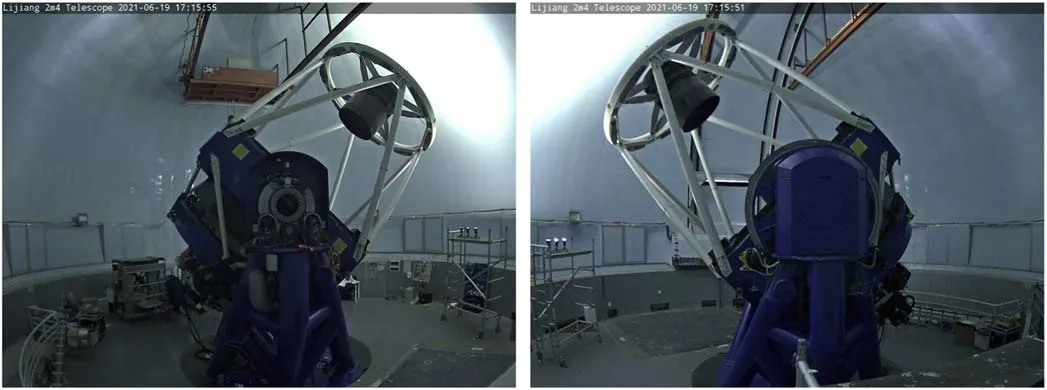
Figure 14. A screenshot of the observation process of the dome flat-field.
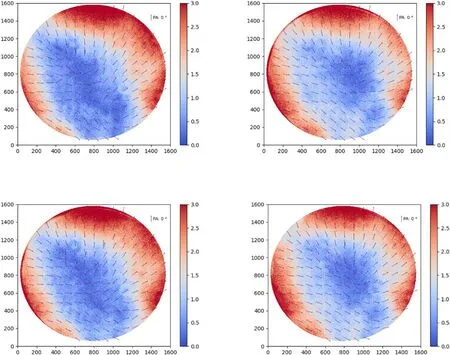
Figure 15. The polarization characteristics of the unpolarized domeflat when rotating the Cassegrain axis (The color represents the PD and the arrow indicates the direction of the PA).
During the night observation, the Cassegrain axis is always rotating to eliminate the field rotation effect, so the YFPOL rotates with it. In order to analyze the instrumental errors of YFPOL under various angles,we take the dome flat-field at 37 different angles of the Cassegrain rotation axis(hereafter using Rot_Angle).The 37 Rot_Angles range from-180°to 180°(in steps of 10°), which cover the entire rotation range of the axis(-240°~+240°). We take 12 images at each Rot_Angle:three images are taken for each modulation angle,and there are at least four modulation angles (0°, 45°, 90° and 135°) for getting the unpolarized dome flat-field at each Rot_Angle. So,we get at least 454 images (444 domeflat images and 10 bias images) for a particular filter.
For the data reduction, we first combine the three images at the same modulation angle into one image by taking the median value, so we can acquire 148 images from the 444 domeflat images.Second,all the images are subtracted with the masterbias (combined by the 10 bias images), and then all the images are cropped from 2k×2k pixels to 1k×1k pixels.After that,four processed images at each Rot_Angle are used to calculate the PD and PA values for each pixel.Finally,we can obtain 37 IPC graphics including the PD and PA information for the 37 Rot_Angles.
We select four special Rot_Angles(0°,90°,180°and-90°)to show the results in Figure 15.The circular area in the figures corresponds to the YFPOL’s effective FOV,that is 7′.From the 37 IPC graphics, we summarize the following characteristics:(1) the distributions of instrument PD and PA have obvious structure in the full field, and the PA changes dramatically in the less polarized region. (2) In general, the instrument PD increases gradually along the radial direction. The instrument PD is about 0.04%~0.07% in the center, and up to 3% at the edges of the field. (3) As the axis rotates, the polarization characteristics change together.
In order to further study the change of IPCs with Cassegrain axial rotation, we calculate the PD differences between Rot_Angle=0 and all other Rot_Angles, and plot the curves of minimum, maximum and median values in Figure 16.Obviously,the maximum PD difference is about 1%and occurs in the orthogonal direction.

Figure 16. The PD difference between Rot_Angle=0° and all other Rot_Angles.
3.1.2. Fully-polarized Case
The “fully-polarized” case presented here and in the next section (Section 3.2) is different from the “fully-polarized”light in the laboratory test as mentioned in Section 2.5.Although they are all generated from a light source(LED light,unpolarized standard star or halogen lamp)and a polarizer,the results are totally different. We can get the 100% polarized light in the laboratory, but not on the telescope. The main reason is that the polarizer is in the parallel path in the lab,but cone-shaped path on the telescope.
The observation process is similar to laboratory tests. We installed the new version polarizer P2 on the YFUA wheel to get the “fully polarized” domeflat, and installed the other new version polarizer P3 on YFUB wheel as a polarization analyzer. So, we get the “fully-polarized” domeflat at four modulation angles 0°,90°,45°and 135°by rotating P2,which correspond to+Q′,-Q′,+U′ and-U′ , respectively. Because we cannot get 100%polarized light,we use symbolsQ′ andU′ ,not symbols Q and U.The results of PD and PA for+Q′ ,-Q′,-U′ and+U′ are shown in Figure 17,and the median values of PD and PA are listed in Table 1.The results have the following characteristics: (1) as we expected, 100% polarization cannot be achieved by the polarizer on the YFUA wheel. (2) The distribution of the PD in the entire FOV is obviously different from that in the unpolarized domeflat. (3) The direction of PA shows obvious consistency.As a result,we cannot calibrate the YFPOL by the PCU (polarizer A on the YFUA wheel), as we cannot get 100% polarized light as a reference.
There are several factors that can account for the polarization characteristics of unpolarized and fully-polarized dome flatfield: (1) the YFOSC optical system, including the collimating and imaging optical systems that could produce the structural characteristics of the PD and PA in the field. (2) The polarizer is not mounted in a parallel path, but rather in a cone-shaped light path in front of the focus, which contributes to the structural characteristics of the PD and PA in the field.(3)The misalignment of the three axes (the optical axis of the telescope, the axis of the Cassegrain rotation and the axis of the polarizer rotation) can introduce errors, which include the axis position errors and tip-tilt errors as discussed by Liang et al. (2019). These errors are the main factors leading to the 1% PD difference at 37 Rot_Angles. (4) The imperfect hyperboloid and the imperfect symmetry of optical axis of primary and secondary mirrors can introduce small errors in the wide field. (5) The inhomogeneity of contrast ratio and transmittance parameters at different positions of the polarizer can also bring small errors in the wide field. The first three reasons should be the main factors leading to the polarization characteristics of YFPOL.
If the IPCs obtained by the dome flat-field are stable,we can minimize the instrumental errors through flat-fielding by using the unpolarized domeflat. If we choose the domeflat with the angle position closest to the Rot_Angle of the observed object,in theory,we can reduce the instrumental PD errors to 0.2%in the entire FOV,because the PD difference is normally less than 0.2% when the Rot_Angle difference is within 10 degrees as displayed in Figure 16. We also compared the differences of domeflat under different dates,which are less than 0.2%in the full field. So, we need further confirmation about the IPCs of YFPOL by observing the sky targets.
3.2. Target Observation
3.2.1. Unpolarized Case
In order to confirm the polarization characteristics of the unpolarized domeflat,we observed the open cluster NGC 2682 on 2022 March 10.

Figure 17.The polarization characteristics of the fully-polarized domeflats at four different angles(The color represents the PD and the arrow signifies the direction of the PA).
For the data reduction, all the data are masterbias subtracted and then cosmic rays are eliminated. After the aperture photometry by SExtractor, we get 104 targets’ polarized information(PD and PA)in the open cluster(Figure 18(a)).The rotation angle of the Cassegrain axis is -115°.3 during the observation, and so the unpolarized domeflat with Rot_Angle=-120° is selected for comparison (Figure 18(b)).We can find that the distributions of PD and PA in the entire FOV are consistent with each other.
3.2.2. Fully-polarized Case
In order to confirm the polarization characteristics of the fully-polarized domeflat, we observed the zero-polarized standard star BD+332642 on 2022 March 9.
As described for a fully polarized domeflat,we use the PCU(polarizer P2 on the YFUA wheel) to change zero-polarized standard star BD+332642 to a fully polarized star,and rely on the PMU (polarizer P3 on the YFUB wheel) to measure its polarization state. Actually, for the same reason as we discussed above, we cannot get the 100% polarized target byPCU. We find almost the same results as the fully-polarized domeflat (see Table 1) as shown in Table 2.

Table 1 Results of the Fully Polarized Domeflat when Rot_Angle=38
In conclusion, we obtained the IPCs in the full FOV for YFPOL by analyzing the unpolarized domeflat, and then we confirmed the same polarization characteristics by observing the sky targets. We found that the IPCs are stable for a certain Rot_Angle of Cassegrain rotation axis, and the IPCs will change when the axis rotates. Since the stable IPCs can be obtained by the unpolarized domeflat and the sky targets,and it should be able to be reduced by dome flat-fielding for scientific data.
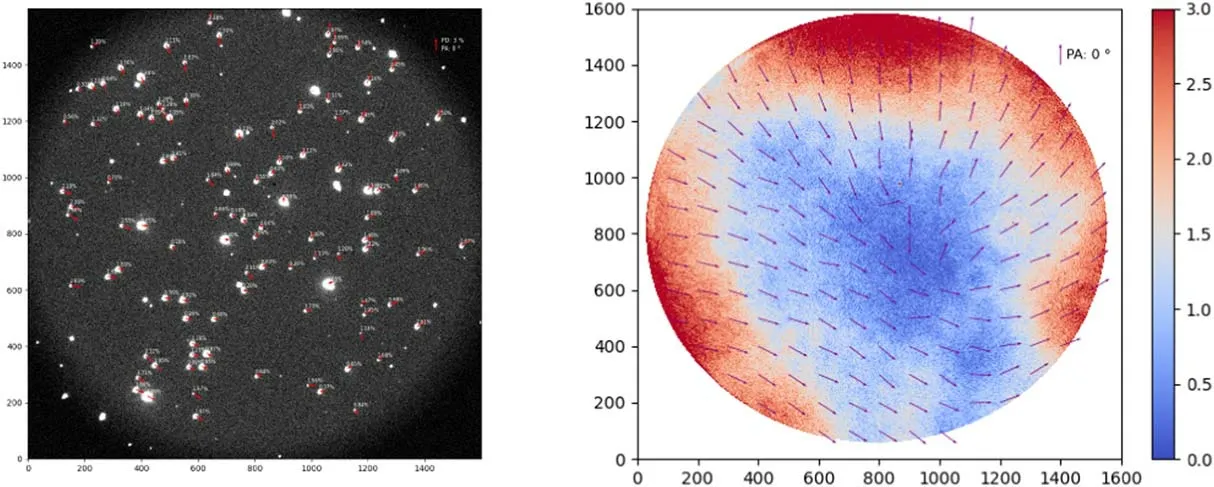
Figure 18. The polarization characteristics of the open cluster NGC 2682 and the dome flat-field.
4. Error Analysis
Many observational factors can affect the accuracy of magnetic-field measurements. For YFPOL, we list 10 sources of error in four aspects:
I. Optical system: errors from the telescope optical system,optical properties of the polarizer, optical systems of scientific instrument and cross-talk between Stokes I, Q and U parameters.
II. Mechanical system: errors from the rotation positioning accuracy of the polarizer and Cassegrain axis. The misalignment of the three axes:the optical axis of the telescope,the axis of the Cassegrain rotation and the axis of the polarizer rotation.
III. Data reduction: errors from Poisson statistical noise and aperture photometry noise (King et al. 2014).
IV.Atmospheric effect:errors from atmospheric turbulences(seeing) and sky background changes (Packham 2008).
4.1. Optical System
4.1.1. Ritchey-Chrétien Optical System
When photons strike the metal coated mirror surface, each unpolarized ray of light gets polarized due to reflection. Since R-C optics are two hyperbolic mirror reflection optical systems,the ray of light must be polarized.If the object is on the axis of the telescope, we will have complete circular symmetry for these rays and the net polarization effect will be zero in theory(Sen & Kakati 1997). However, the field angle will produce some finite value of instrumental polarization for an off-axisobject point. As discussed in Sen & Kakati (1997), the instrumental polarization values introduced at 90″off-axis field are 0.016% for an unpolarized star and 99.998% for a 100%polarized star at the Cassegrain focus. Therefore the instrumental polarization introduced by the R-C optical system is too small to be detected by YFPOL (10-3).

Table 2 Results of Fully Polarized Star
4.1.2. YFOSC Optical System
YFPOL is a polarimeter integrated with YFOSC, so its optical system (including the collimating and imaging optical systems) would definitely produce instrument errors. From the discussion in Section 3, we know that the IPCs of YFPOL are mainly due to the focal-reducer optical system. This kind of instrumental error is very common in similar instruments,such as VLT-FORS1(Patat&Romaniello 2006).For YFPOL,when the target is in the center of the FOV, the instrumental error is about 0.3%; when the target is at the edge of the FOV, the instrumental error is up to 3.0%. Therefore, it is the most critical error affecting the observation accuracy of YFPOL.Through our data processing scheme (Section 5), the instrument error can be reduced to less than 0.2%in the full FOV of YFPOL.
4.1.3. Error from Polarizer
Since December 2021,we have replaced the latest version of the polarizer, which has an excellent contrast ratio(1,000,000:1, see Figure 6) and higher transmittance in the optical band.As we mentioned in Section 2.5,it is much better than the old version polarizer and fully meets the measurement accuracy requirements for YFPOL.
4.1.4. Crosstalk between I, Q and U Blazars are our primary observation targets, which have a high linear polarization, and the circular polarization is hardly detected (Hutsemékers et al. 2010). So we only discuss the crosstalk effects among Stokes parameters I, Q and U.Assuming the situations where V=0, we can get Equation (9) from Equation (1).
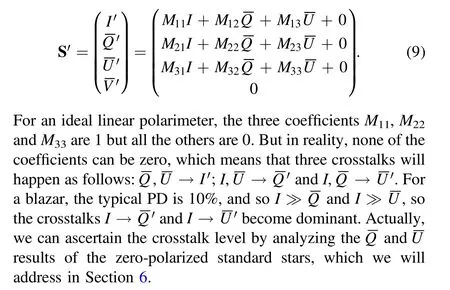
4.2. Mechanical System
4.2.1. Polarizer Rotation
YFPOL is essentially an analyzer that polarimetrically modulates incident light by rotating a polarizer, so the rotation positioning accuracy and repetition accuracy of the polarizer will directly affect the polarization measurement accuracy. As we have introduced in Section 2.2,the polarizer rotation control precision is better than 0.01°. Meanwhile, the repeated positioning accuracy is guaranteed by always rotating the polarizer in the same direction, which effectively avoids backlash error.Therefore, the error introduced by the polarizer rotation is negligible for YFPOL.
4.2.2. Cassegrain Axis Rotation
The servo control accuracy of LJT’s Cassegrain axis is better than a microarcsecond.It is good enough that the rotation itself would not introduce errors. However, the IPC changes along with the rotation of Cassegrain axis, which will introduce rotation errors.The maximum error is up to 1.0%when the axis rotates 90 degrees, as affirmed in Figure 16. Through our data processing scheme(Section 5),this error can be reduced to less than 0.2%.
4.3. Data Reduction
4.3.1. Statistical Error


4.3.2. Data Reduction Error
Many factors can introduce measurement errors in data processing, including flat-fielding, cosmic ray pollution,improper aperture and so on. In the data reduction software of YFPOL (see Section 5), the following measures have been taken to reduce the above errors: (1) the most suitable unpolarized domeflat is selected for the preprocessing of scientific data. (2) The cosmic ray elimination program is running before the aperture photometry, to eliminate cosmic ray pollution to the observation target or reference stars.(3)We use the optimal aperture to obtain the total flux for each target.Through the above strategies,the data reduction errors could be reduced to a lower level.
4.4. Atmospheric Effect
The polarization accuracy could be influenced by atmospheric turbulence (seeing) and change in sky background emission and transmission if the modulation of the polarimetric signal is slower than those variations (Packham 2008; Casini et al.2012).For a single-beam polarimeter,the error introduced by atmospheric variation is more obvious.
4.4.1. Atmospheric Seeing
According to the theory of atmospheric turbulence, the characteristic timescale t0of atmospheric turbulence is about 0.01 seconds, which is much shorter than our shutter response time (0.5 seconds). Furthermore, one set of polarization data consists of four images taken at different times. The typical modulation cycle τ is 2 minutes for YFPOL. Therefore, the error introduced by atmospheric seeing cannot be eliminated,both for photometric observations and polarization observations. There are two ways to reduce this error: shorten the modulation cycle τ by using a large telescope (Patat &Romaniello 2006) or freezing the air turbulence by using the EMCCD’s advantages to stack multiple short exposure images(Słowikowska et al.2016).Actually,the sampling period τ for YFPOL is about 2 minutes for brighter targets (see Section 6),or 6 minutes for fainter targets (see Section 7). During a clear night,the atmospheric seeing varies very little within 6 minutes at Lijiang Observatory (Xin et al. 2020). Meanwhile, we use the optimal aperture to obtain the total flux on each image,which can partially eliminate the flux error introduced by the atmospheric seeing.
4.4.2. Skylight Background
Polarization observations are always carried out on clear nights when the sky is stable, so the biggest influence on the sky background is the Moon. Słowikowska et al. (2016)checked the correlations between the observational conditions and derived polarization values. They did not find any correlations of the PD or the PA with the Moon phase or the Moon distance from the source in any of the observed energy ranges.From our polarimetric results of zero-polarized standard stars,the fluctuation of skylight is an important factor affecting the measurement accuracy, which can bring about 0.5% PD error on some clear nights (see Section 6).
5. Pipeline
Based on the principle of both quality and efficiency, we developed quasi-automatic polarization data processing software for YFPOL based on Python3,8https://www.python.org/downloads/release/python-3810/because Python is the most commonly used and open source software to automate a data reduction workflow (Freudling et al. 2013; Nastasi et al.2013).There are mainly four steps in the software workflow as illustrated in Figure 19, and their details will be described below.
(I) Preparation
All observational data of the YFPOL are automatically classified into four groups: bias, flat, scientific data and trash.Bias data are the zero second exposure background images,which are collected before and after the observation night;Flat data include the skyflat images collected during the twilight time, and the domeflat images collected during the daytime using the LED light sources; Scientific data are night observation data of zero-polarized standard stars, highlypolarized standard stars and highly polarized targets;The trash data are useless or failed observation images. CCD gain and readout noise are calculated by the software using two bias images and two skyflat images (Howell 2000). The bias data are automatically processed by the software through the following order: stack 10 bias images and take their median value as the masterbias. We collect the unpolarized domeflat images on 37 angles of Cassegrain rotation axis once a month,and all the domeflat images are bias subtracted, cropped to 1k×1k and then normalized. Through the above preparation,all the public data are ready for scientific data preprocessing.
(II) Preprocess
The scientific data are first cropped to the same size as domeflat image, and then subtracted with the masterbias.Finally, the suitable flat-field data will be selected automatically by comparing the angle of Cassegrain rotation axis for science data θsand the angle of Cassegrain rotation axis for domeflat θf. For example, when θs=134°, the corresponding domeflat is θf=130°; when θs=-8°, the corresponding domeflat is θf=-10°. After that, the cosmic ray elimination program(using the Astroscrappy package9https://astroscrappy.readthedocs.io/en/latest/index.html,van Dokkum 2001)will be performed for the pre-processed data. Especially for long exposure images, there is a high probability of cosmological contamination for the target or reference stars.
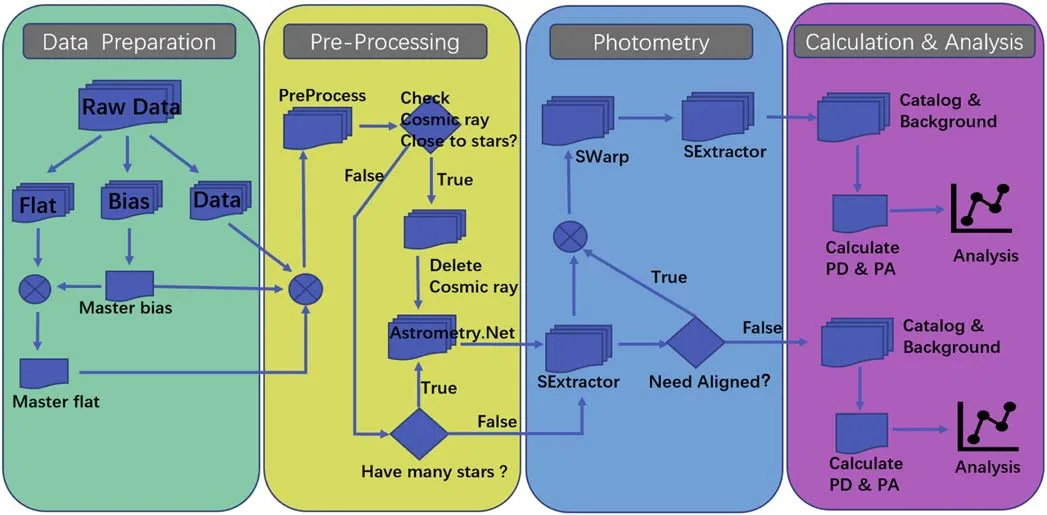
Figure 19. The workflow of YFPOL’s pipeline.
(III) Photometry
The World Coordinate System(WCS)coordinates in a FITS header will be updated (using Astrometry.net10https://astrometry.net/) before the aperture photometry process. This step is very helpful for locking on the same target in the four modulated images.When there are too few objects in the field to resolve more precise coordinates, we will use the maximum flux method to lock on the same target in the four modulated images.
In general, the following step is to perform the aperture photometry.But for polarization data processing,especially for extended sources, it is best to align all the images exactly by SWarp11https://www.astromatic.net/software/swarp/at first, and then perform the aperture photometry by SExtractor12https://sextractor.readthedocs.io/en/latest/(Bertin & Arnouts 1996). Image alignment (with north at the top and east on the left)helps us to check whether the sky angle(RKA in Equation(7))is 0 during the observation,which directly affects the result of PA.
(IV) Calculation
From the catalogs extracted by SExtractor, we can lock on the same target in the four modulated images by the high precision coordinates or the maximum flux method.Therefore,we can extract the AUTO_FLUX (I0, I45, I90, I13http://simbad.cds.unistra.fr/simbad/5) from catalogs of the four modulated images for each locked target.The Stokes I, Q and U parameters are calculated by Equations (3), (4) and (5). The PD and PA are obtained by Equations (6) and (7), and the corresponding errors are obtained by Equations (10) and (11). It should be noted that the errors are obtained by the number of photons, not ADUs.
6. Calibration
Calibration is the most important issue for any polarimeter.The best calibration scheme is to analyze the instrument polarization error by using a standard polarization source.However, this is not possible for most night astronomical polarimeters, including YFPOL. The alternative calibration scheme is to observe the polarization standard stars (Słowikowska et al. 2016; Ramaprakash et al. 2019). Therefore, we carried out long-term monitoring targeting zero-polarized and highly-polarized standard stars since April 2021. Because of the hardware upgrade of YFPOL, we divided the calibration process into two epochs:
Epoch 1: Calibration observation with the old version polarizer from April 2021 to June 2021.
Epoch 2:Calibration observation with the new version of the polarizer since December 2021.
In order to carry out polarization calibration,we summarized the zero-polarized standard stars (Table A1) and highlypolarized standard stars (Table A2) from the Hubble Space Telescope (HST) (Schmidt et al. 1992), and updated the magnitude, spectral type and coordinate information according to SIMBAD.13http://simbad.cds.unistra.fr/simbad/Objects fainter than 6 0 are suitable for YFPOL. Otherwise, the target image will saturate even at the shortest exposure time (0.5 seconds).
6.1. Calibration in Epoch 1
In Epoch 1, one zero-polarized standard star (BD+332642)and three highly-polarized standard stars (HD204827,HD161056 and HD155528) were observed. There are 15 nights of data for BD+332642, two nights of data for HD204827, three nights of data for HD161056 and 10 nightsof data for HD155528. We provide five constraints on these data: (1) the flux values of the target on four polarization modulation angles must be complete; (2) The observed sky area must be clear, as judged by all-sky camera images (Xin et al.2020);(3)Atmospheric seeing should be better than 5′′,as judged by the seeing data of the Differential Image Motion Monitor(DIMM)system(Xin et al.2020);(4)The SNR of the target should be greater than 10.(5)The above conditions must be met at the same time in all observation bands.According to the above constraints,some data of the observation target need to be deleted: seven points from BD+332642 data and six points from HD155528 data. As there are no R-band observations for HD204827 on 2021 April 26, all the polarization observations are valid for HD204827 and HD161056, and their PD errors are much lower than other targets. So, HD204827 and HD161056 are ideal highlypolarized standard stars for long-term monitoring.

Table 3 Results of Zero-polarized Standard Star BD+332642
For BD+332642, the polarization calibration observations with V-band and R-band were taken on eight nights, and the observation process is described below: When the telescope is pointed at the target,we select a filter(V or R)and the polarizer to enter into the light path,and then rotate the polarizer to four modulation angle positions to collect four images respectively.After that,the polarizer should be rotated to the home position(0 degree position) for the next observation. The sampling period of a set of polarization observations is about 2 minutes for one filter band and 4 minutes for two filter bands,when the exposure time for each image is 10 seconds. All the polarimetric results of BD+332642 are displayed in Table 3.The range of PD is 0.35%~0.94% in the V-band and 0.30%~0.80% in the R-band.
For highly-polarized standard stars HD204827, HD161056 and HD155528,the PD and PA results are shown in Tables 4,5 and 6.The δP in the tables represent the PD difference between our results and HST results (see Table A2). The δθ represents the PA difference between HST results and our results.Because we use three highly-polarized standard stars with different PAs, we can determine the instrumental PA offset ZPA by the median of the three targets δθ, which is about 82°.
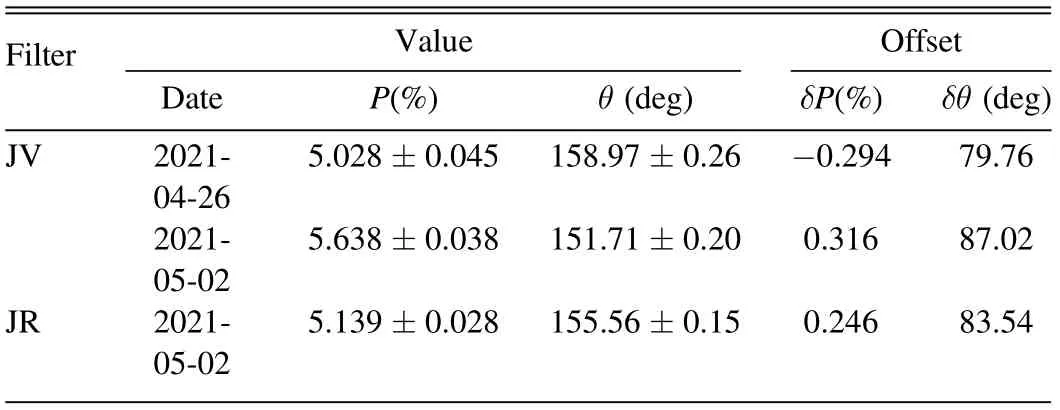
Table 4 Results of Highly-polarized Standard Star HD204827
6.2. Calibration in Epoch 2
A lot of hardware upgrades were done by November 2021,including:(1)the primary mirror was re-aluminized in October 2021; (2) the support system of the primary mirror was readjusted, which improved the image quality. We designed and realized the wireless charging function of the polarizer control system, which improved the stability of YFPOL, as there is no need to replace the battery before the observation nights.(3)The polarizer was replaced by a new one with much higher contrast ratio in the optical band, and the mounting angle was rotated 90 degrees compared to the previous one.
Until 2022 March 7, we had observed one zero-polarized standard star: G191B2B (17 nights in the R-band and the Vband),and two highly-polarized standard stars:HD19820(five nights in four bands) and HD25443 (20 nights in the R-band and the V-band; five nights in the B-band and the I-band).Applying the same constraints as described in Epoch 1, some data points are removed for each target: two points from G191B2B data;three points from HD19820 data; six points in the R-band and the V-band,and one point in the B-band and the I-band from HD25443 data. The data were deleted mainly because of bad weather.
For G191B2B, 16 nights of data are shown in Table 7, and the measured PD is a little higher than the results of HST(PD=0.061% on the V-band, see Table A1). The exposure time and sampling period are the same as the zero-polarizedstandard star BD+332642 in Epoch 1.A special case should be noted here, the Moon distance was 27 degrees and the Moon phase was 80% on 2022 February 11. These results should be ignored,as they are probably influenced by the Moon.All other results are valid, as the Moon distances are all greater than 30 degrees. Another phenomenon needs to be explained. The PD values of the target in the two bands are quite different during some nights,such as:2022 February 19 and 2022 February 27,which reflects the polarization fluctuation caused by the change of atmosphere during the sampling interval (4 minutes). Even during a clear night, the atmospheric change can bring about 0.5% PD error, which represents the level of PD errorintroduced due to atmospheric changes at Lijiang Observatory.Obviously,it is a disadvantage of the single-beam polarimeter.The range of PD for G191B2B is 0.10%~0.79%in the V-band and 0.16%~0.65%in the R-band,based on 15 nights of valid data. The PD decreased by 0.15% compared to those of BD+332642, which shows the improvement of YFPOL performance after the hardware upgrades.

Table 5 Results of Highly-polarized Standard Star HD161056

Table 6 Results of Highly-polarized Standard Star HD155528
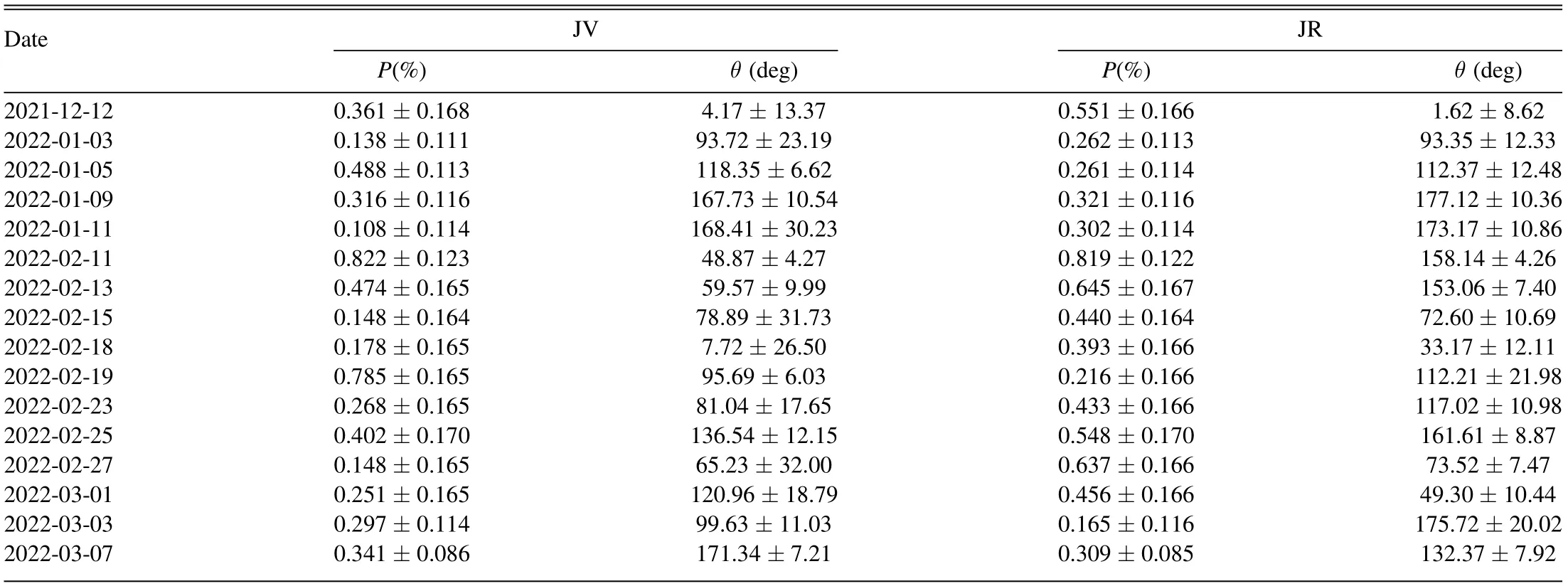
Table 7 Result of Zero-polarized Standard Star G191B2B

Table 8 Result of Highly-polarized Standard Star HD19820
For highly-polarized standard stars, Table 8 displays the results of HD19820 on two nights in four bands, and Table 9 lists the results of HD25443 on 14 nights in two bands and four nights in four bands.The measured PAs for HD25443 are very stable, so we can obtain a reliable ZPA value according to the median of δθ;it is about 2.6°.The new ZPA value can be used to correct the instrument PA measured by YFPOL in the future.
7. Results of Blazar S5 0716+714
Blazars are a subclass of radio-loud AGNs, which manifest rapid and large variability from radio to γ-ray bands, high and variable polarization, prominent nonthermal emission, etc.(Urry&Padovani 1995).Blazars consist of flat-spectrum radio quasars and BL Lac objects.S5 0716+714(R.A.=07:21:53.4,decl.=+71:20:36.4) is a typical BL Lac object discovered in 1979 (Kühr et al. 1981).
We present the polarimetric results of S5 0716+714 in the V-band. The temporal resolution is about 7 minutes, and the exposure time of each image is 60 seconds. As there are no zero-polarized standard stars in the FOV of S5 0716+714, we select two reference stars Ref_A and Ref_B (see Figure 20,corresponding to targets 5#and 2#on the website14https://www.lsw.uni-heidelberg.de/projects/extragalactic/charts/0716+714.htmlprovided by the University of Heidelberg)to assess the uncertainty of the polarimetric results of S5 0716+714.
In order to verify the effectiveness of domeflat field processing in eliminating the instrument polarization effect,we compared two kinds of pipelines: (1)Pipeline1: In the data preprocessing stage, the unpolarized domeflat field processing is performed, which is called “with flat-field” for short. (2)Pipeline2: In the data preprocessing stage, no flat-field processing is performed, which is called “without flat-field”for short.
Table 10 shows two nights of polarimetric results through these two pipeline modes, and the PDs obtained by Pipeline1 are smaller than those obtained by Pipeline2. Obviously, the lower PD values are more reliable for unpolarized stars Ref_A and Ref_B.Furthermore,Ref_B(V=11 46)is much brighter than Ref_A (V=13 55). The measured PD of Ref_B should be lower than that of Ref_A, as the SNR of Ref_B is higher than that of Ref_A.However,the PD values of Ref_B are much higher than those of Ref_A through Pipeline2, because the Pipeline2 cannot reduce the PD error introduced by IPCs,especially for the target close to the edges of the field.Therefore, the results through Pipeline1 are closer to the true values. The polarization characteristics obtained by the results through Pipeline2 support the IPCs as we summarized in Section 3.1.1.
Figures 21 and 22 depict the time dependent curve of Stokes parameters (I, Q/I, U/I) and PD of the two reference stars,where I represents the change of target intensity.Obviously,the Q/I and U/I obtained by Pipeline1(green line)are much closer to 0.0%than those obtained by Pipeline2(yellow line),and the phenomenon is even more evident for Ref_B.By comparison, we can arrive at the following conclusion:Pipeline1 can effectively minimize the instrumental errors in the entire FOV of YFPOL. We introduced the workflow of pipeline1 in Section 5, and it is the recommended pipeline for YFPOL in the future. Actually the polarimetric results of polarization standard stars(in Section 6)and S5 0716+714 are obtained through Pipeline1.
We collected 21 and 17 data points for S5 0716+714 on the two nights, and the results are depicted in Figures 23 and 24.As Ref_A is closer to the target than Ref_B,we select Ref_A to correct the results of S5 0716+714.The correction process foreach parameter is described below: The Stokes parameter I is obtained by Equation(3),and then the total flux is converted to instrumental magnitude MTiby

Table 9 Result of Highly-polarized Standard Star HD25443

where Mi=30 for YFPOL. Then we can find the visual magnitude MTvby

where MAiand MAV=13 55 are the instrumental magnitude and visual magnitude of Ref_A respectively. At last, MTvwill be subtracted by the Galactic extinction (V=0 085 for S5 0716+714), and then we get the final corrected visual magnitude of S5 0716+714, as displayed in the top panels of Figures 23(b) and 24(b). The corrected parameters Q/I, U/I and PD of the target are obtained by subtracting the corresponding values of Ref_A. The PA parameter of the target is corrected by adding the ZPA value.
Through the above data post-processing process, we can finally analyze the polarimetric results of S5 0716+714. The PD is always changing and the median is about 6.0%during the two nights, and there is no correlation between the variability of the optical flux and the optical PD. The PA is always swinging at a small angle in one night,and it rotates about 32°in 24 hours.
8. Summary and Conclusions
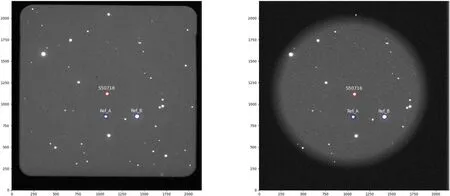
Figure 20. The images of S5 0716+714 by YFOSC (a) and YFPOL (b) in V-band.
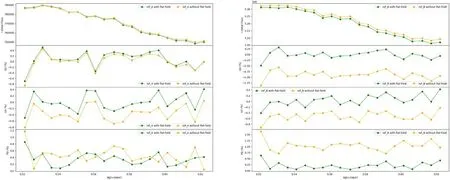
Figure 21. Comparison of polarimetric results under two pipeline modes on 2022-03-09.

Table 10 Results of S5 0716+714 and Reference Stars
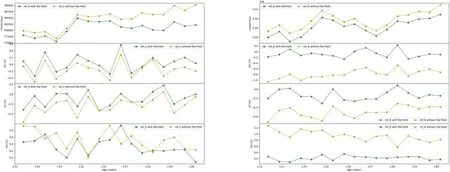
Figure 22. Comparison of polarimetric results under two pipeline modes on 2022-03-10.

Figure 23. Linear polarization curve of S5 0716+714 and Ref_A on 2022-03-09.
This paper has introduced a new polarimeter, YFPOL,operated at the Cassegrain focus of the LJT. As the YFOSC is always positioned on the Cassegrain focal plane of the telescope, the ultra-thin polarizer rotation control system with wireless charging and control was custom developed for YFPOL, which is suitable for mounting on the YFOSC’s rotation wheels.
Actually, the YFPOL is a polarimeter that is integrated with YFOSC. The main disadvantage is that the focal-reducer optical system of YFOSC brings about an obvious polarization characteristic effect, which is probably common to any polarimeter that is integrated with a focal-reducer instrument.The advantage is that YFPOL can also be used as a spectropolarimeter, because the YFOSC has a spectral observation mode with slits and grisms. In this paper, we studied in detail the IPCs in the full FOV of YFPOL, by observation and analysis of the unpolarized domeflat and an open cluster. We also developed the standard data reduction software to minimize the instrumental polarization error. The effectiveness of the software has been verified through the polarimetric results of blazar S5 0716+714 and two reference stars.
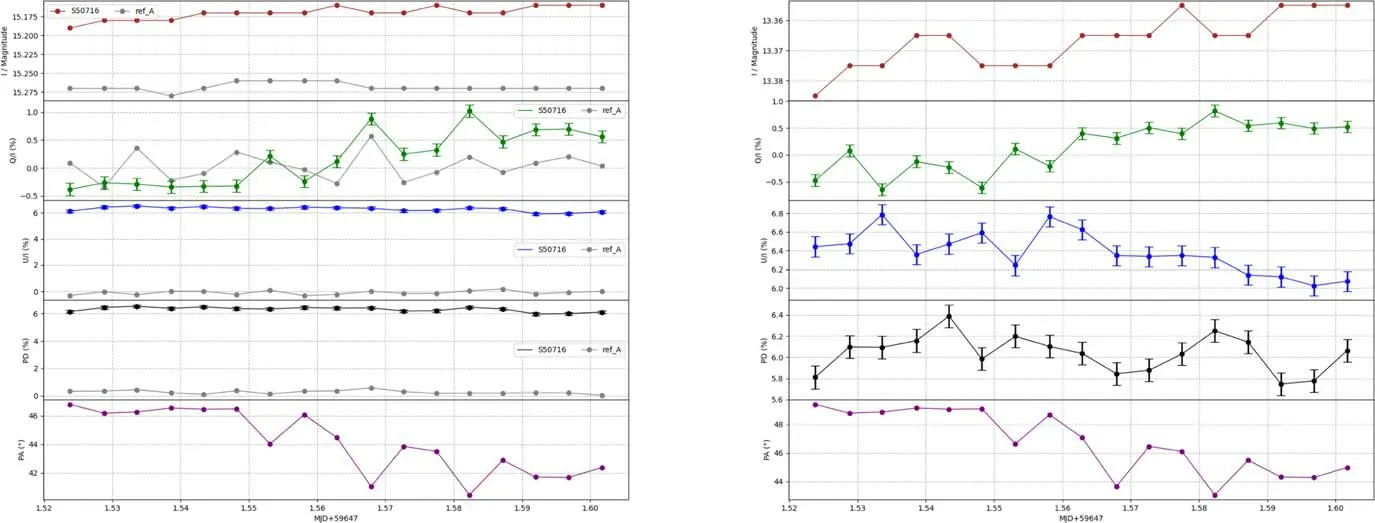
Figure 24. Linear polarization curve of S5 0716+714 and Ref_A on 2022-03-10.
Error analysis and calibration are the key issues for YFPOL.Here we listed 10 sources of error, which are mainly from the following four aspects:optical system,mechanical system,data reduction and atmospheric effect. The error from the focalreducer optical system is the most critical factor, especially when the target is at the edge of the field. Therefore, we introduced the YFPOL pipeline in detail, as it can effectively reduce the instrumental polarization error. Finally, the calibration is performed by observing the zero-polarized and highlypolarized standard stars. For the new version of the polarizer since December 2021, the systematic uncertainty of the PD is better than 0.8%for a V=11 68 target with 10 s exposure and 2 minute sampling period, and better than 0.85% for a V=14 17 target with 60 s exposure and 7 minute sampling period.The instrument PA offset is about 2°.6,which is used to correct the PA value for YFPOL.
Acknowledgements
We sincerely thank the anonymous referee for constructive comments leading to significant improvement of this paper.We are very grateful to Thomas Augusteijn, Anlaug Amanda Djupvik, Tapio Pursimo and the team of Nordic Optical Telescope (NOT), who gave us a detailed introduction about the polarimeters on NOT. We are also very grateful to Stuart Bates and Iain A.Steele in Liverpool John Moores University,who introduced RINGO3 to us and extended our knowledge on polarization instruments. This work was supported by the National Key R&D Program of China with No.2021YFA1600404, the National Natural Science Foundation of China(NSFC, Grant Nos.11991051,11573067,11673062,11527804,U1931206 and 11873091),the CAS“Light of West China” Program, the Yunnan Province Basic Research Plan with No. 2019FA001 and the China Manned Space Project with No. CMS-CSST-2021-A06. This research uses data obtained through the Lijiang 2.4 m Telescope, which is funded by Yunnan Province, Chinese Academy of Sciences and NSFC.
Appendix Polarization Standard Stars List
We reorganized and updated Hubble’s polarizing standard star information,includes a list of zero-polarized standard stars and a list of highly-polarized standard stars (Tables A1 and A2).
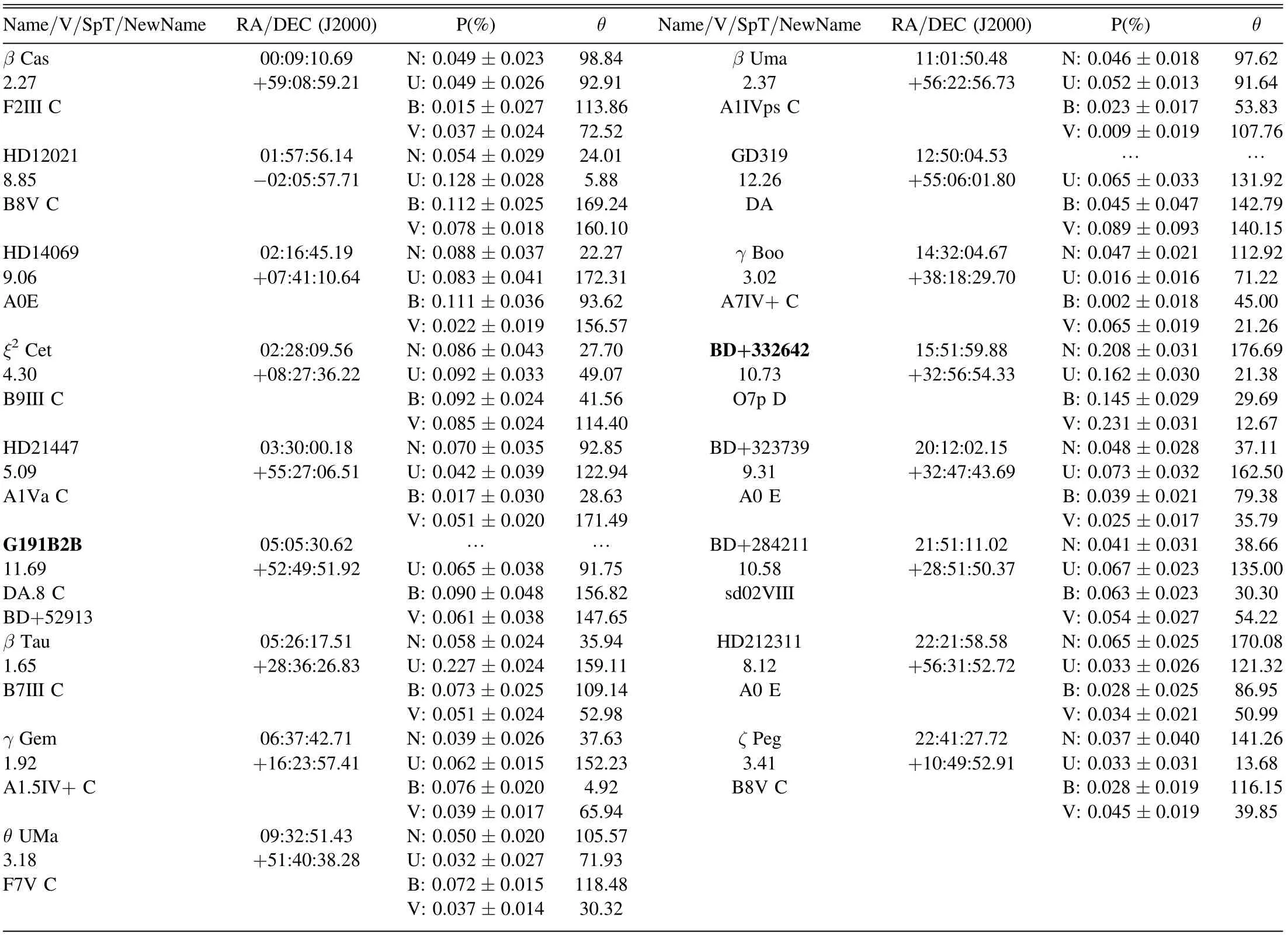
Table A1 Zero-Polarized Standard Stars

Table A2 Highly-Polarized Standard Stars
ORCIDiDs
Yu-Xin Xin https://orcid.org/0000-0003-1991-776X
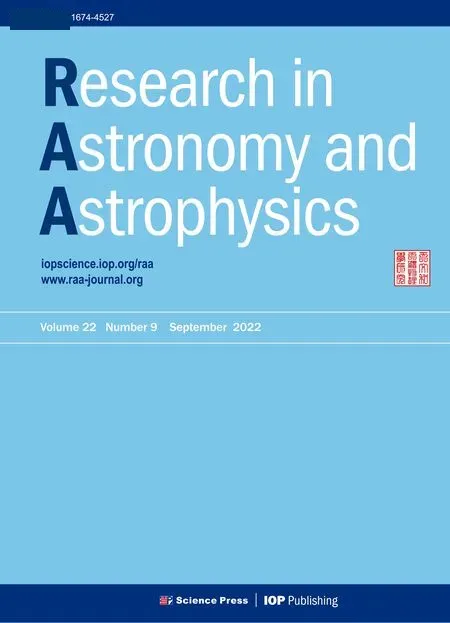 Research in Astronomy and Astrophysics2022年9期
Research in Astronomy and Astrophysics2022年9期
- Research in Astronomy and Astrophysics的其它文章
- A Wideband Microwave Holography Methodology for Reflector Surface Measurement of Large Radio Telescopes
- Pre-explosion Helium Shell Flash in Type Ia Supernovae
- A Region Selection Method for Real-time Local Correlation Tracking of Solar Full-disk Magnetographs
- Research on the On-orbit Background of the Hard X-Ray Imager Onboard ASO-S
- Chinese Sunspot Drawings and Their Digitization—(VII) Sunspot Penumbra to Umbra Area Ratio Using the Hand-Drawing Records from Yunnan Observatories
- Supergranular Fractal Dimension and Solar Rotation
